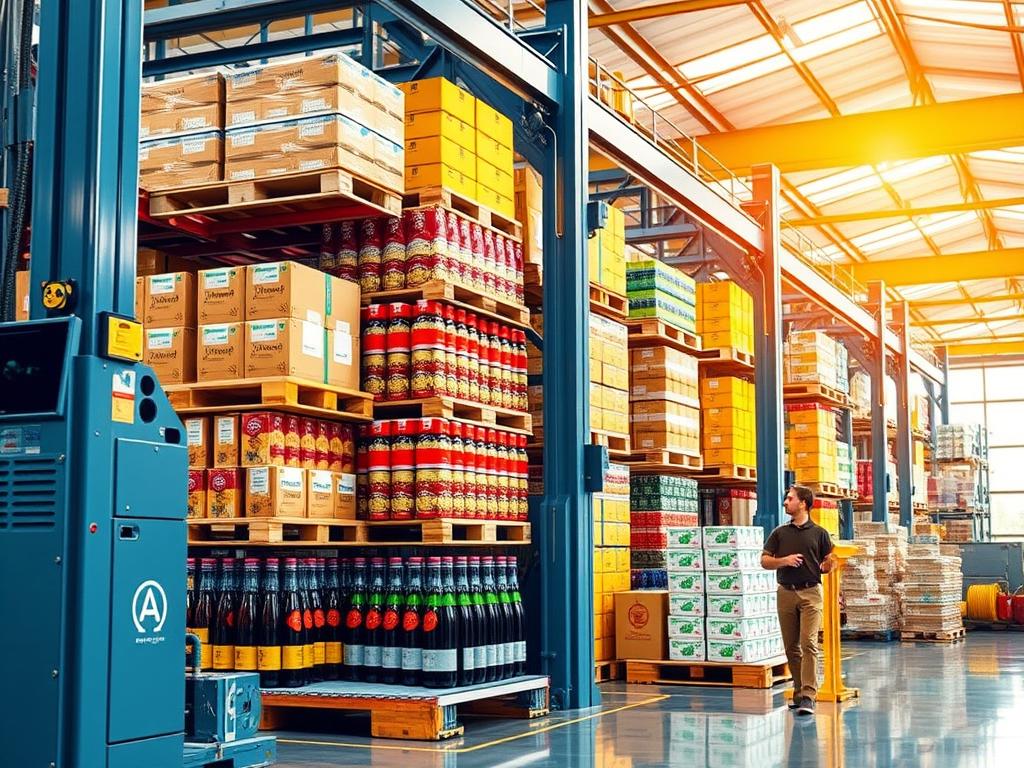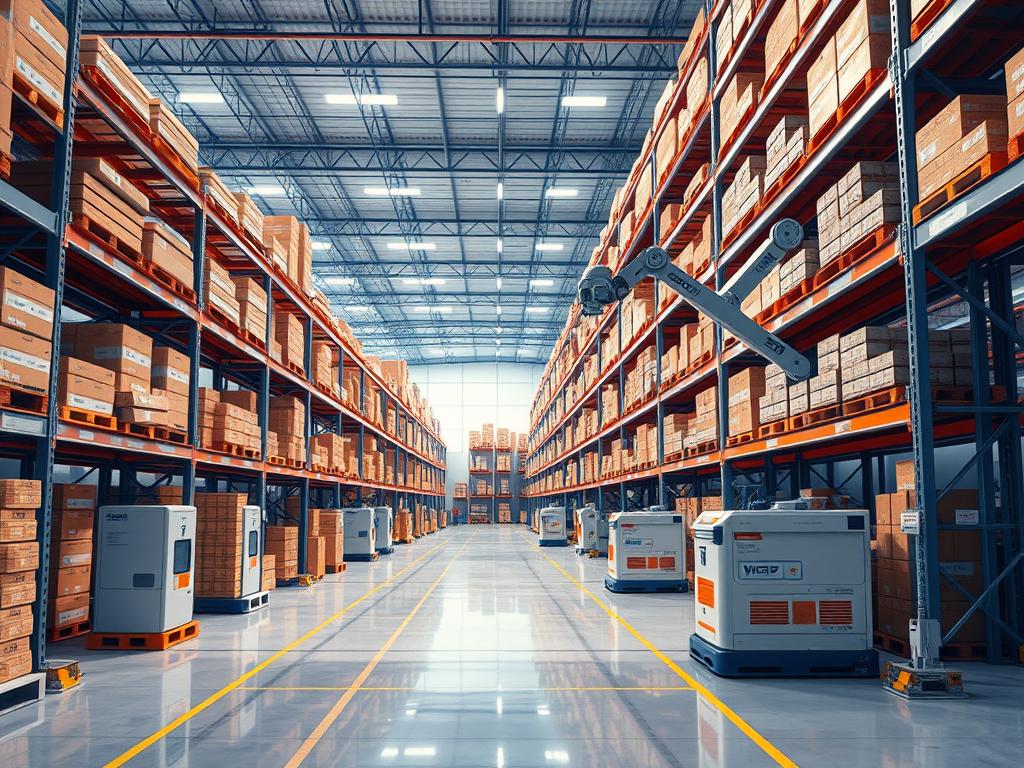Automated palletizing boosts productivity by cutting labor costs and errors. In today’s warehousing, space is scarce and efficiency crucial. Compact palletizers are the ideal solution for businesses aiming to streamline operations.
Robotic warehouse automation is evolving rapidly. These systems meet high-speed production needs while saving space. Features like pallet truck take-off and low profile conveyors revolutionize warehouse logistics.
Industrial mobile robots and autonomous guided vehicles enable flexible, efficient warehousing. Compact palletizers come in static, auto, and auto with pallet feeder configurations. These systems suit various automation levels and operational complexities.
Space-efficient palletizers allow facilities to grow without costly floor plan changes. This makes them attractive for businesses of all sizes. Let’s explore how compact palletizers enhance warehouse efficiency.
Understanding Industrial Mobile Robots
Industrial mobile robots are changing manufacturing and warehousing. These machines perform tasks with precision and efficiency. They’re part of the growing industrial robotics field.
From material handling to mobile manipulation, these automated assistants are reshaping modern industry. They boost productivity and streamline operations in various sectors.
What Are Industrial Mobile Robots?
Industrial mobile robots move around facilities autonomously or semi-autonomously. They perform various tasks with advanced sensors and navigation systems. These robots operate safely alongside human workers.
They excel in material transport, inventory management, and complex assembly operations. Their versatility makes them valuable assets in modern manufacturing environments.
Key Features and Capabilities
Industrial mobile robots are constantly improving. Modern robots have advanced navigation for obstacle avoidance. They use precision sensors for accurate positioning.
These robots offer flexible programming interfaces for easy task customization. They integrate with factory management systems for smooth operations.
With 24/7 operation and minimal maintenance, these robots significantly boost productivity. They enhance efficiency in various manufacturing settings.
Types of Industrial Mobile Robots
Several types of industrial mobile robots exist, each for specific tasks:
- Autonomous Guided Vehicles (AGVs): Used for material transport along predefined routes
- Autonomous Mobile Robots (AMRs): More flexible than AGVs, capable of navigating dynamic environments
- Collaborative Robots (Cobots): Designed to work safely alongside humans in shared spaces
- Mobile Manipulators: Combine mobility with robotic arms for versatile task execution
These robots are driving smart factory and warehouse evolution. They enhance efficiency and reduce operational costs across industries.
The Role of Compact Palletizers in Warehousing
Compact palletizers are changing warehousing. These robots boost efficiency in factory automation systems. They revolutionize how goods are stacked and stored.
How Compact Palletizers Work
Compact palletizers are smart robotics systems. They blend advanced robotics with efficient conveyor systems. These industrial robots handle various payloads with customizable grippers.
The pallet configurator software is user-friendly. It allows quick setup and reduces training time. This leads to faster deployment in warehouses.
Benefits of Using Compact Palletizers
Compact palletizers offer many benefits to warehousing operations:
- Increased productivity: Robotic palletizing systems work faster than manual methods, boosting production efficiency.
- Reduced labor costs: These systems can operate 24/7 without breaks, significantly cutting labor expenses.
- Enhanced safety: By performing dangerous and repetitive tasks, robots minimize the risk of injury to human workers.
- Space efficiency: Compact palletizers like the Model 72AN by A-B-C Packaging Machine Corp occupy up to 30% less floor space than traditional floor-level palletizers.
- Flexibility: These systems can be easily moved between production lines, maximizing utility across the entire facility.
| Feature | Benefit |
|---|---|
| Remote monitoring | Electronic analysis of performance |
| Collaborative design | Safe interaction with human workers |
| Versatile handling | Process products up to 25 kg |
| Quick ROI | Typically within two years |
Compact palletizers are key in modern logistics. They drive efficiency in warehousing operations. These systems are essential for innovative factory automation strategies.
Advantages of Space-Saving Solutions
Space-saving solutions offer big benefits for businesses. Innovative systems like industrial mobile robots transform warehouse operations. These systems include autonomous guided vehicles.
Increased Warehouse Efficiency
Robotic warehouse automation boosts efficiency dramatically. Industrial mobile robots can work non-stop, reducing downtime and increasing productivity. Studies show autonomous guided vehicles can improve picking rates to 800 items per hour.
Enhanced Flexibility and Scalability
Mobile robots offer unmatched flexibility in warehouse operations. They adapt easily to various tasks and storage needs. Their modular nature allows for easy scaling as production demands grow.
Improved Safety and Reduced Labor Costs
Autonomous guided vehicles enhance workplace safety by handling risky tasks. This automation also cuts labor costs significantly. Some warehouses have reduced their workforce needs by over 50%.
| Metric | Before Automation | After Automation |
|---|---|---|
| Labor Dependency | 22 associates | 9 associates |
| Productivity | Varies | 800 picks/hour |
| Training Time | Several days | Less than 1 hour |
Robotic warehouse automation streamlines operations effectively. It allows employees to focus on more strategic tasks. This shift improves job satisfaction and retention rates.
Real-World Applications of Compact Palletizers
Compact palletizers are changing material handling in many industries. These robots improve efficiency and safety in warehouses and production facilities. They streamline operations and make work easier for everyone involved.
Automotive Industry
Compact palletizers excel at handling heavy parts in car manufacturing. Since 2010, the auto sector has been the top buyer of these robots. They manage engine blocks and transmissions, cutting manual labor and speeding up production.
Food & Beverage Sector
Compact palletizers are a big help in the food and drink industry. They handle delicate packaging carefully while keeping things clean. Delta robots are fast and accurate, perfect for quick pick-and-place tasks.
These robots shine in packaging, where they sort and stack products rapidly. They work non-stop, ensuring consistent quality throughout the process.

E-commerce Operations
E-commerce is using more compact palletizers for quick order fulfillment. The market for these robots could hit $66 billion by 2027. Online shops are choosing mobile robots for their flexibility.
Autonomous mobile robots (AMRs) move goods around warehouses with ease. They work better than old conveyor systems. These smart robots use AI and computer vision to pick and place orders.
“Compact palletizers are transforming how we handle materials across industries. They’re not just about efficiency; they’re about reimagining what’s possible in warehousing and logistics.”
The Technological Advancements in Robotics
Robotics is evolving fast, reshaping factory automation and logistics robots. New tech creates smarter, more efficient systems. These robots can handle complex tasks and adapt to changing production environments.
AI and Machine Learning Integration
AI and machine learning are transforming intelligent robotics systems. NXP’s MCX N Series MCUs boost machine learning capabilities. This allows robots to make smarter decisions and adapt to new situations.
IoT Connectivity and Automation
IoT is changing how logistics robots communicate and operate. MQTT and CoAP protocols connect mobile robots with other devices. This creates a smooth network of automation.
5G networks enable better communication for mobile robotics. Their low latency and high bandwidth improve robot performance.
Future Trends in Robotics
GaN tech is making smaller, more efficient motor drivers for mobile robots. This results in longer battery life. New battery tech, like sodium-ion batteries, offers lower costs and better availability.
Mesh networking and swarm robotics are enabling multi-robot teamwork. This opens up new possibilities for complex manufacturing tasks.
| Industry | Demand for Industrial Robots | Key Applications |
|---|---|---|
| Automotive | High | Assembly, Welding, Painting |
| Electronics | High | Pick and Place, Soldering |
| Metal | High | Cutting, Forming, Welding |
| Chemical and Plastics | Growing | Injection Molding, Packaging |
| Food and Beverage | Growing | Packaging, Palletizing |
Addressing Common Concerns
Robotic warehouse automation brings unique challenges. Businesses must carefully consider these issues. Industrial mobile robots and autonomous guided vehicles require thoughtful integration.
Cost Considerations for Implementation
Robotic systems need a hefty upfront investment. However, increased productivity often leads to quick returns. Nearly 2 million industrial robots are used worldwide.
The efficiency gains from AMRs can result in major long-term savings. This trend shows automation’s growing importance in the industry.
Maintenance and Support Issues
Regular upkeep is vital for industrial mobile robots. It boosts their lifespan, uptime, and overall performance. Proper maintenance prevents costly repairs.
- Routine inspections to spot wear and tear
- Cleaning and lubrication of components
- Battery checks and replacements
- Software updates for improved functionality
Tackling these tasks early helps avoid system overhauls. It ensures smooth operations in the long run.
Employee Training and Transition
Robotic warehouse automation needs a skilled workforce. Training programs help employees adapt to new roles. Staff can move from manual tasks to managing autonomous vehicles.
This change improves efficiency and workplace safety. It creates a more dynamic work environment.

Tackling these issues is crucial for success. It ensures smooth integration of robots in warehouses. The industry’s future depends on addressing these concerns effectively.
Best Practices for Implementation
Industrial robotics needs careful planning. The global robotics market may hit $74 billion by 2026. Adopting best practices is key for successful integration.
Assessing Your Warehouse Needs
Evaluate your warehouse operations first. Look at production volume, product variety, and space limits. This helps choose the right material handling robot.
Autonomous mobile robots (AMRs) are often cheaper and easier to integrate. They can be a good choice for many warehouses.
Choosing the Right Provider
Picking the right provider is crucial. Look for industrial robotics experts with strong support. Evaluate providers on system flexibility and meeting your needs.
Work with integrators to plan robot deployment. They can help optimize your facility’s layout.
Developing a Comprehensive Strategy
Create a strategy that fits your warehouse operations. Consider these key points:
- Plan for seamless integration and employee training
- Ensure reliable Wi-Fi for remote tracking and management
- Involve IT early to solve network issues
- Encourage employee buy-in through training and skill development
- Run pilot tests to check workflows before full rollout
These practices help implement mobile manipulation solutions well. They can boost your warehouse’s efficiency and productivity.
Looking Ahead: The Future of Compact Palletizers
Compact palletizers are set to transform warehouse operations. The global palletizing robot servo system market is worth about $2.5 billion. New tech advancements promise exciting changes in logistics robots.
Innovations on the Horizon
Intelligent robotics systems are taking factory automation to new levels. Apex Motion Control’s milk jug palletizer can stack 20 jugs in two cycles. FlexLink’s RI20 palletizing cell offers seamless pallet exchange for closed boxes.
These innovations are boosting production capacity significantly. They showcase the potential for increased efficiency in warehouse operations.
The Impact of Robotics on Labor Markets
As palletizers advance, the labor market is changing. Jobs are shifting towards skilled roles in robot operation and maintenance. This trend is most evident in the Asia-Pacific region.
Rapid industrialization in Asia-Pacific is driving the highest growth in the palletizing robot market. This shift is reshaping the workforce landscape.
Environmental Considerations and Sustainability
Sustainability is now crucial in compact palletizer development. Van der Graaf’s SSV Series Drum Motors lead this change. These motors work for 80,000 hours without maintenance.
In food processing, these motors cut washdown time and water use by half. This aligns with the industry’s move towards eco-friendly practices.


